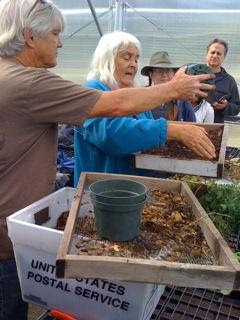Wendy holds up plant for root division
Class Notes: 10/14
Growing Plants Through Strikes
- Taking a strike off of the mother plant – just pull off a piece of the original plant
- Better than cutting because cell walls stay intact if you pull and let the plant divide
- Remove all lower leaves – the stem cells can create leaves (which it already did) as well as roots (which it now will have the chance to do
- Cut top leaves at an angle
- Stick material into perlite at 45-degree angle
- Water daily but don’t disturb (by checking for roots) for 6 weeks
- This is a great way to keep the genetic material of the plant in tact
- After awhile, though, the vigor of the plant will wear down and need to propagate through sex to remain strong and vital
Mix for Making Good Potting Soil
- When you start plant from seed, it does not need rich soil; lean, well-drained, retentive soil
• 1/3 natural soil – so that the plant will be used to the culture of the native soil
• 1/3 sifted leaf mold – adds structure and retains water; can also use coco peat or peat moss; vermiculite also
• 1/3 sharp sand – for drainage; not salty Sandy Lawrence
- No matter what, cut in some native soil from where it will ultimately live; if not, the plant will be in shock when it goes to its final home
Great idea for compost: Create a ‘barrel’ with chicken wire; fill with oak leaves, in a year you’ll have good soil
Steve and Wendy sift leaf mold
Class Notes : 10/21
NYT ran an article on zero waste yesterday
SF made it illegal to throw away food scraps
(very exciting stuff!)
What is propagation?
- How to grow. How to increase plant material. The many ways plant material can be spread and shared.
- Sexual propagation – blending of genetic material; annual and bi-annual plants always spread this way; sometime perennials too
- Asexual propagation – taking a strike or cutting and spreading the same genetic material
What does it mean to cultivate soil?
- To turn the wheel of life. Culture is a wheel. To create, clean culture in the ground. To go down into the ground, into the depths to dig down into, to weed.
Great suppliers – call for catalogues
1. Peaceful Valley Farm Supply
2. Harmony Farm Supply
To Create Strikes
- Months or weeks before, cut the lead off of the mother plant – encouraging it to send up other major stems to replace it
- When the plant is in seed, it wants to spread by seed; so look to divide plants when they are flowering but before they’ve gone to seed
- Now is a very good time to be doing this
- A good strike (the bit that has been pulled off) should feel woody at the base
- You want your strike to be no more than 8”, preferably less
- Remove the lower leaves – roots will grow from these stem cells
- Create a balanced strike – about ½ will go into the ground, the other ½ above the surface
- Seeds push material equally above and below ground. We need to create this same balance when we create plants from strikes.
- Put at 45-degree angle into perlyte
- Water daily, water deeply
Root Division
- Easiest way to divide a plant is to pull it apart. When not doing that to create a strike, can do by pulling small bits of the plant complete with roots
- Look for healthy root mass in mother plant
- Pull off woody base growth (or cut)
- Cut off most on top – especially biggest bits (more than I would have thought)
- If root exceedingly long, cut it too
- Looking to create balance
- Plant in lunch mix (see below)
- Fall is the season to be separating plants by root division!
- Oregano, tarrogon, sage – a lot of the herbs can be separated now
Looking to create a balance of roots and tops
Hardening Seedlings
- When plants are grown from seeds, one thing to consider is that they cannot be planted outside until they’ve been ‘hardened’
- This means getting them acclimated to the outdoor conditions – this is after having been raised early on in a green house
- Harden plants by setting them outside for hours at a time until they spend a couple of nights outside; then they’re ready to be put into the ground
- Not as important in our mild climates as other places
Wendy puts a strike in perlite
Speedling Flats – made of white Styrofoam; every pocket is cone-shaped; easier for mass planting
- Planting soil should be peat-based – coco peat (or peat moss – try to avoid using); to help with water retention
- Cannot use sand because Styrofoam doesn’t absorb water so drainage is not an issue
- A little bit (not much) of native soil
- Pinch of perlyte (white stuff that you use for strikes)
- No compost – it is too rich




No comments:
Post a Comment